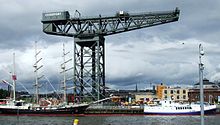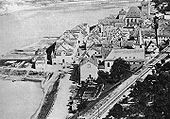Harbor crane
A harbor crane is a crane that stands on the quay for loading and unloading ships .
History of the harbor crane
Stationary harbor cranes - unknown in antiquity according to current knowledge - are seen as a new development from the Middle Ages. The typical harbor crane was a rotating construction equipped with two treadmills . These cranes were built for loading and unloading cargo directly on the quay, where they replaced or supplemented older lifting methods such as winches , seesaws and yards . For aerodynamic reasons, occasional treadle cranes were erected on a several meter high basalt foundation ( bastion, roundabout, shipyard ) on oak piles rammed into the river mud (Andernach, Trier).
Three types of harbor cranes with different geographical focuses can be identified: On the one hand, gantry cranes, the entire construction of which rotated around a central, vertical axis, and which were usually found in Flemish and Dutch coastal towns ( Bruges , Nieuwpoort , Antwerp , Mechelen , Gent ) . On the other hand, tower cranes, where the cable winch and running wheels were in a fixed tower, and only the boom (also with double boom for ballast (Trier) or as a second hoist (Würzburg)) and roof rotated with the load. This type was common in German sea and inland ports, but also in Sweden. Thirdly, cranes in which the crane house with the drive wheels were separated from the boom. The latter stood separately as a rotating boom in front of the crane house. Such cranes were common in England (Guildford, Harwich), but also on the continent. The second crane from St. Goar (built in 1658 under Landgrave Ernst I ) belonged to this type: The treadwheels ran in the octagonal four-story stone tower, while the actual boom stood as a gallows between the crane house and the quay, in the quay floor and a covered wooden structure from the crane house roof starting out, not unlike a rigid boom, was clamped.
In addition to the treadmill cranes, there were also corrugated gear cranes . Here, the drum or the log to take up the rope was driven by hand with mostly two corrugated wheels at both ends of the roller and an endless rope running over it. A replica of such a crane is in Otterndorf . Another variant is the reel crane, in which the running wheels are replaced by two huge reels similar to a capstan with a vertical axis, as the replica in Vlaardingen , South Holland shows.
Interestingly, quay cranes have not been adopted in the Mediterranean and the highly developed Italian port cities, where authorities made use of the more labor-intensive method of unloading via ramps beyond the Middle Ages. A mixture of ramp and pedal crane can be found in the Mont Saint-Michel monastery , an inclined pedal elevator.
In contrast to construction cranes (still present in some church roof trusses such as in the north tower of the Frauenkirche in Munich , in Freiburg and Gmünder Münster ), where the working speed was determined by the relatively slow work rhythm of the bricklayers, port cranes usually had a double wheel to speed up the loading process. The two pedal wheels with a diameter of over 4 m (up to 6.5 meters in the crane gate, up to 7.4 m on the earlier Mecheler crane) were attached to both sides of the crane axis and rotated together to pick up or lower the chain or the Rope. According to an investigation, nineteen (fifteen original) step wheel cranes, a corrugated gear crane and a reel crane from pre-industrial times still exist in Europe today. In addition to these stationary cranes, floating cranes or crane ships appeared as early as the 14th century (Düsseldorf, Cologne, Andernach, Trier, etc.), which could be used flexibly throughout the port basin, but were at risk from floods, ice and storms.
36 m high mast crane (1748–51) in Copenhagen for setting up sailing ship masts
Stockholm : cannon crane from 1751
Utrecht city crane around 1800 (1402–1837)
Germany
|
|
|
|
Sankt Goar : octagonal stone crane from 1658, around 1860 |
In order to save time, double tricycles attached to both sides of a rotating tower were usually used in shipping when operating the harbor cranes, which had been widespread since the Middle Ages. These tower cranes were built either from wood or stone and could handle loads of up to 2.5 tons when loading. It is estimated that around 80 cranes were in use at 32 crane locations on the Rhine with tributaries, in the entire German-speaking area around twice as many.
From the middle of the 13th century, port cranes appeared as a replacement or addition to the reel drive in port cities such as Hamburg , Bruges , Ghent or Antwerp , as well as in cities with stacking rights, such as B. in Strasbourg, Trier or Cologne, where there were four pedal cranes in the 16th century ( Cologne city view from 1531 by Anton Woensam ), one of which was 20 m high. It was also a sovereign (electoral and archbishop's) privilege to erect a crane and operate it by a crane master, or a city's approval for the construction and operation of a crane was required. In Koblenz, the octagonal stone house of the former Koblenz Rhine crane (built in 1611 by Johann II von Pasqualini ) can still be seen as a gauge house on the Rhine (250 m north of the palace complex), in St. Goar the octagonal stone crane from the 17th century stood until the end of 1869 Century (predecessor mentioned in a document in 1484) south of the port basin at that time. Wenzel Hollar drew it around 1635, a color lithograph St. Goar & Rheinfels by François Stroobant shows almost the same successor building from 1658 in 1860.
A pre-industrial pedal crane required including a sworn crane master who was in the service of the crane leaser or the city council and was responsible for the payment of the employees (including crane clerks, rope greasers) in and on the crane as well as the handling of the crane business, and the winch servants running in the wheels a 15– A team of 25 people who belonged to their own guild of Aufläder or Kärrner . The Aufläder or hospital real - not to be confused with the wind servant , winch operator , Radläufer , Crane offender or crane working in the treadwheels or on the drawbar in the crane house, worked outside of the crane on the crane load on the quay or in the ship.
Switzerland
In Basel , port cranes are nothing special at the Rheinhafen . From April 2014 to January 2015, a port crane stood on Limmatquai in Zurich as an art installation by the group around Jan Morgenthaler : For a long time, heatedly discussed in the media, a Rostock port crane from 1963 as part of the Zurich Transit Maritime project towered over Zurich's old town for a few months .
List of historic harbor cranes
The following is a list of preserved harbor cranes in (formerly) German-speaking countries. Modern reconstructions are also listed.
| Surname | city | Waters | history | material | image |
|---|---|---|---|---|---|
| Crane gate | Danzig | Motlawa | 1367, remodeling 1442-1444; oldest lifting device in the (former) German-speaking area | Stone and wood |
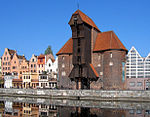
|
| Moselle crane, old crane | trier | Moselle | 1413, in operation until 1910 (497 years) | stone |

|
| Rhine crane | Bingen | Rhine | 1487, renewed in 1819, in operation until 1890 (~ 400 years). After extensive renovation, it has been in operation again for tourist demonstrations by the Bingen am Rhein monument society since 2008. | Wood on a stone base |

|
| Rhine crane, old crane | Then after | Rhine | 1554–1561 as a replacement for floating crane from approx. 1400, in operation until 1911 (350 years) | stone |

|
| Oestrich crane | Oestrich-Winkel | Rhine | 1744–1745, in operation until 1926 (181 years) | Wood |

|
| Mainkran, Alter Kranen | Wurzburg | Main | 1767–1773 by Franz Neumann , in operation until 1846 (73 years) | stone |

|
| Historic crane | Hanau | Main | 1869, in operation until 1924 (55 years) | Cast iron and stone (base) |

|
| Customs crane | trier | Moselle | 1774, in operation until 1900 (126 years) | stone |

|
| Mainkran, Alter Kranen | Market wide | Main | 1784 (previous wooden building destroyed by ice drift), in operation until 1900 (116 years) | stone |

|
| Wooden crane (corrugated wheel) | Otterndorf | Medem | ~ 1780 (broken off in 1942, later replica) | Wood |
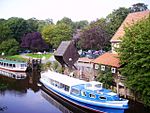
|
| Old crane | Luneburg | Ilmenau | 1330, 1379 and 1797 new building (ice drift) in operation until 1860 (530/63 years (new building)) | Wood |
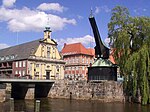
|
| Harbor crane | Rostock | Warnow | ~ 1620 stone crane, 1780–1887 wooden crane in front of the castle wall gate ; 1996 reconstruction | Wood |

|
| Old salt crane | Stade | Swing arm | 1661–1898 (demolished; 237 years), 1977 reconstruction based on the Lüneburg crane | Wood |

|
| Old Saar crane | Saarbrücken | Saar | 1762 by FJ Stengel , renewed in 1784; decay since 1865 (103 years); 1989–1991 replica | Wood on a stone base |

|
| Bamberg crane | Bamberg | Regnitz | seen on the city views by Braun / Hogenberg and Matthäus Merian ( engraving 1640 ); Demolished in the 19th century | Octagonal half-timbered building on stone foundation | Watercolor from 1818 |
| Kampnagel cranes | Hamburg-Altona-Altstadt | Northern Elbe | Built by Kampnagel in 1939 and used on the Lübeck shore. Transferred to the Altonaer Holzhafen in 1989 . | Luffing slewing crane |
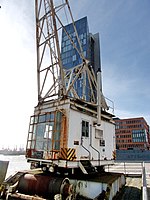
|
| Stadskraan, Havenkraan | Vlaardingen | Nieuwe Waterweg | Predecessor 1626; Original built in 1858, replaced by a steel crane in 1909; 1996 replica | Double reel gantry crane, wood on a wooden frame |

|
| Stadskraan (Havenkraan) | Mechelen | Dijle | 1311 wooden crane near crane bridge (Kraanbrug), new building 1346, 1369, 1430, 1455, 1765, 1886 demolished | Double trestle crane, wood on wooden frame | Photo ca.1870 |
See also
- Grúa Fairbairn (Fairbairn crane), Seville
literature
- Brian Cotterell, Johan Kamminga: Mechanics of Pre-industrial Technology . Cambridge University Press, Cambridge 1992, ISBN 0-521-42871-8
- Hans-Liudger Dienel , Wolfgang Meighörner: The Tretradkran . In the series: History of Technology (publications by the Deutsches Museum ), Munich 1995 and 1997; ISBN 3-924183-33-3 .
- Alexander Grebel: History of the city of St. Goar . Verlag Carl Sassenroth, St. Goar 1848.
- Hans-Joachim Krause, Richard Scharnagel: The pedal crane in Marktbreit am Main . A consideration of the hoist from 1784, its load-bearing capacity and performance in stationary operation and the risk to its crane treads in transient operation. Self-published, Marktbreit 2004.
-
Michael Matheus :
- Medieval port cranes . In: Uta Lindgren (Hrsg.): European technology in the Middle Ages 800–1400 4th edition. Berlin 2001, ISBN 3-7861-1748-9 , pp. 345-348.
- Harbor cranes. On the history of a medieval machine on the Rhine and its tributaries from Strasbourg to Düsseldorf . In: Trier Historical Research , Volume 9. Trier 1985.
- Andrea L. Matthies: Medieval Treadwheels. Artists' Views of Building Construction . In: Technology and Culture , Vol. 33, No. 3, pp. 510-547. Johns Hopkins University Press , Baltimore 1992; ISSN 0040-165X .
- Monika Stöckl: Fixed harbor cranes: Crane buildings from the 15th to 18th centuries on the Rhine, Main and Moselle . Term paper for obtaining the academic degree of a Magister Artium. University Press, Mainz 1986.
Web links
- The Hafentechnische Gesellschaft e. V. deals with all scientific and practical questions of a technical and economic nature in the areas of ports, shipping and logistics as well as their requirements for the modes of transport and coastal protection .
- History of the "old crane" in Lüneburg
- Main crane in market width
Individual evidence
- ↑ more photos etc. in the Finnieston Crane in the English language Wikipedia
- ↑ a b c Michael Matheus : Medieval harbor cranes . In: Uta Lindgren (Hrsg.): European technology in the Middle Ages 800–1400 4th edition. Berlin 2001, ISBN 3-7861-1748-9 , p. 345
- ↑ a b Michael Matheus : Medieval harbor cranes . In: Uta Lindgren (Hrsg.): European technology in the Middle Ages 800–1400 4th edition. Berlin 2001, ISBN 3-7861-1748-9 , p. 346
- ↑ View from the north of the customs house and the Rhine crane with an outstanding boom, around 1800 ( memento of the original from October 6, 2014 in the Internet Archive ) Info: The archive link was inserted automatically and has not yet been checked. Please check the original and archive link according to the instructions and then remove this notice.
- ↑ Michael Matheus : Medieval harbor cranes . In: Uta Lindgren (Hrsg.): European technology in the Middle Ages 800–1400 4th edition. Berlin 2001, ISBN 3-7861-1748-9 , p. 347
- ↑ These are located in Bergen (Norway); Stockholm and Karlskrona (Sweden); Copenhagen (Denmark); Guildford and Harwich (England); Lüneburg, Stade, Rostock, Otterndorf ( Wellradkran ), Marktbreit, Würzburg, Oestrich, Bingen, Saarbrücken, Andernach and Trier (2) (Germany); Vlaardingen (reel crane, Netherlands); Gdansk (Poland). The cranes in Karlskrona, Copenhagen and the Danziger Krantor are designed as mast cranes without a swiveling jib. Cf. Michael Matheus : Medieval harbor cranes . In: Uta Lindgren (Hrsg.): European technology in the Middle Ages 800–1400 4th edition. Berlin 2001, ISBN 3-7861-1748-9 , p. 346
- ↑ Rhine crane in St. Goar 1635 by Wenzel Hollar
- ↑ Zurich harbor crane has been erected . In: NZZ , April 17, 2014.
- ↑ Done, the harbor crane is up . In: Zürcher Tages-Anzeiger , April 17, 2014.

